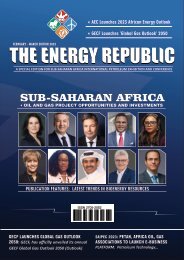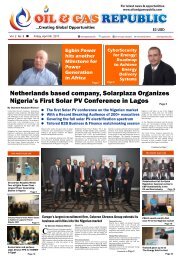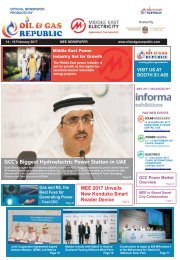Oil and Gas Republic SAIPEC Special Edition 2020
Oil and Gas Republic's quarterly magazine explores the global oil and gas industry, featuring the latest trends in the industry. This publication is a SPECIAL EDITION focused on the Sub-Saharan Africa International Petroleum Exhibition & Conference 2020. In this publication, we also featured some of the industry's latest trends especially in Sub-Saharan Africa region where there are number of projects underway and industry experts have forecast that the region will contribute about 2.3 million barrels per day (mmbd) of global crude and condensate production and about 9.6 billion cubic feet per day (bcfd) of global gas production in 2025. For more information, please visit our website http://oilandgasrepublic.com
Oil and Gas Republic's quarterly magazine explores the global oil and gas industry, featuring the latest trends in the industry. This publication is a SPECIAL EDITION focused on the Sub-Saharan Africa International Petroleum Exhibition & Conference 2020.
In this publication, we also featured some of the industry's latest trends especially in Sub-Saharan Africa region where there are number of projects underway and industry experts have forecast that the region will contribute about 2.3 million barrels per day (mmbd) of global crude and condensate production and about 9.6 billion cubic feet per day (bcfd) of global gas production in 2025. For more information, please visit our website http://oilandgasrepublic.com
Create successful ePaper yourself
Turn your PDF publications into a flip-book with our unique Google optimized e-Paper software.
INDUSTRY NEWS
Stability is key for supermajor
investment in Africa - IOCs
decisions expected soon, one of which is
Greater Tortue Ahmeyim in Mauritania and
Senegal.”
So why is BP focusing so strongly in Africa?
“First, is that Africa provides opportunity for
growth,” Peijs adds. “Demand for energy in
Africa is well ahead of the world average,
populations are growing, economies are
advancing, the production of energy is growing
even more strongly. Looking ahead the forecast
for energy production in Africa is likely to grow
by around 60% by 2040, almost twice the global
rate.
Although it may appear that much
of the exploration activity in
Africa is driven by smaller
independents, the supermajors still
have a significant role to play. In
recognition of the importance of the
market these supermajors were all well
represented by senior executives at
major industry event in Africa. The key
message they delivered was that they
were ready to invest further in the
region but were looking for investment
opportunities that could offer them
assurance in terms of fiscal and political
stability.
Searching for stable fiscal regimes
When it comes to success in Africa, Pam
Darwin, vice president Africa Exxon
Mobil admits that there is no silver
bullet, but one thing that is crucial going
forwards is access to capital. “Our
industry must continue to strive to
meet energy demand for reducing
environmental impact,” she said. “To do
that we face competition for capital. All
our efforts take capital and the
competition is greater than ever.”
The key she explains is stable and
attractive fiscal regimes; where these
are present investments are occurring.
“There's a clear message from the
United States where investment in the
shale industry or the shale revolution as
they call it has increased dramatically
since 2005,” she adds. “As a
consequence, US liquid production has
more than doubled over ten years,
generating billions of dollars. In
contrast, over the last ten years, African
liquid production has steadily
decreased. In order to tap Africa's
immense reserves, commercial terms
must be in place to draw those investments.
“Investment also needs to focus on making
communities strong, this is really important
for us as a company. We fund programmes
and training, education, and women's
empowerment along with health issues such
as malaria. We've invested nearly $4 billion
since 2000 in these kinds of programmes,
over a billion just in education, and 120
m i l l i o n i n w o m e n ' s e c o n o m i c
empowerment.”
BP growing on a rich heritage
According to Jasper Peijs, exploration vice
president Africa, BP, Africa has been very
important to BP and perhaps BP is
important to Africa as well. He explains that
BP’s current activity and presence is right
across the continent of Africa. “We have a
strong multi decade positions in Angola,
Egypt and Algeria, where we are currently
producing 400,000 barrels a day.”
When it comes to a positive environment for
investment, Peijs points to Angola as a case
in point. “I'm happy to recognise the positive
changes the Angolan Government has
made,” he says. “They are now incentivising
investment again and we as BP have taken
notice. We've extended the licencing for
block 15 and 18 and created a joint venture
to develop gas fields.
But Angola is not alone, you see lots of
positive changes across the continent and
that is why our investment in Africa is
growing. Since 2016, we have delivered
seven major projects and eight scheduled to
come online by the end of the year. These
are in Algeria, Angola, and Egypt, and the
next tranche of major projects have already
been sanctioned with the final investment
“The second reason companies invest in Africa
is that it provides opportunities for competitive
Evy Maffini
partnerships. Since the oil price crash in 2014,
our industry has become much more efficient,
much more disciplined, more selective on
Glacier makes
appointment in
Norway to grow
local business
invested capital. We are all competing on a
global scale but in Africa we have found several
countries providing conditions for investments.
“And then thirdly, is that Africa provides
opportunities for long term; as well as having a
growing energy consumption and production,
economic development is driving up levels of
skills and capabilities across the continents.
These are human resources coming together.
G
So, the great untapped potential of Africa in
every sense.”
Building on success in Angola
One man new to the challenges of the continent
is Mike Sangster, MD Total E&P Nigeria, who
has recently taken over the leadership of Total
exploration and production in Nigeria. “There
are four main technologies that we need to be
strong in to succeed – deepwater, LNG,
petrochemicals, and lubricants. Here in Africa,
we are very much present with three of those
four technologies with deepwater and energy
as well as retailer and lubricants on the
downstream side. We are the leading integrated
major in Africa, we are present in 43 countries
across the continent, all the way across the
value chain from the upstream, the midstream
and downstream
“Almost 20% of our production last year came
from it came from Africa, and 16% of our
reserves are still in Africa. We are currently
investing more than one third of our exploration
budget in Africa. We operate 11 FPSOs across
the continent. The downstream also is going to
come in Africa. We have almost four and a half
thousand service stations across all the
different countries, and about 18% of market
share.”
One of the recent projects that Total sanctioned
was the Kaombo Project in Angola, which
features two FPSOs each with a capacity of
115,000 barrels a day, one of which started
producing in the middle of last year, and the
second one began earlier this year. “We are
producing close to capacity of 230,000 barrels a
day, so it is a major achievement for the
company in the country.















